Blue-and-yellow macaw
| Blue-and-yellow macaw | |
|---|---|

| |
| Male | |
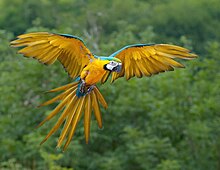
| |
| Female Both at Jurong Bird Park | |
| Scientific classification | |
| Kingdom: | Animalia |
| Phylum: | Chordata |
| Class: | Aves |
| Order: | Psittaciformes |
| Family: | Psittacidae |
| Genus: | Ara |
| Species: | A. ararauna
|
| Binomial name | |
| Ara ararauna | |
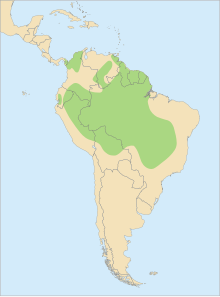
| |
Distribution
| |
| Synonyms | |
|
Psittacus ararauna Linnaeus, 1758 | |
The blue-and-yellow macaw (Ara ararauna), also known as the blue-and-gold macaw, is a large South American parrot with mostly blue top parts and light orange underparts, with gradient hues of green on top of its head. It is a member of the large group of neotropical parrots known as macaws. It inhabits forest (especially varzea, but also in open sections of terra firme or unflooded forest), woodland and savannah of tropical South America. They are popular in aviculture because of their striking color, ability to talk, ready availability in the marketplace, and close bonding to humans. They can also live for 65–70 years.
Taxonomy[]
The blue-and-yellow macaw (Ara ararauna, Linnaeus 1758)[2] is a member of the genus Ara (Lacepede 1799), one of six genera of Central and South American macaws.[3]
Description[]

These birds can reach a length of 76–86 cm (30–34 in) and weigh 0.900–1.5 kg (2–3 lb), making them some of the larger members of their family. They are vivid in appearance with bright aqua blue feathers on the top of their body except for the head, which is lime colored. The bottom, however, is a rich deep yellow/light orange. Their beak is black, as well as the feathers under their chin. Its feet are of a gray color, save for black talons. The bird has white skin, with its face having nearly no feathers beside a few black ones spaced apart from each other forming a striped pattern around the eyes. The irises are pale light yellow.
Blue-and-yellow macaws can live from 30 to 35 years in the wild, and reach sexual maturity between the ages of 3 and 6 years.[4]
Little variation in plumage is seen across the range. Some birds have a more orange or "butterscotch" underside color, particularly on the breast. This was often seen in Trinidad birds and others of the Caribbean area. The blue-and-yellow macaw uses its powerful beak for breaking nutshells, and for climbing up and hanging from trees.[4]
Distribution and habitat[]
This species occurs in Colombia, Venezuela, Peru, Brazil, Bolivia, Ecuador, and Paraguay. The range extends slightly into Central America, where it is restricted to Panama. Although they were nearly wiped out in Trinidad due to human activity during the 1970s, a recent programme of reintroduction has proved successful. Between 1999 and 2003, wild-caught blue-and-yellow macaws were translocated from Guyana to Trinidad, in an attempt to re-establish the species in a protected area around Nariva swamp;[5] despite this, the IUCN still lists them as extirpated from the country. A small breeding population descended from introduced birds is found in Puerto Rico,[1] and another has inhabited Miami-Dade County, Florida, since the mid-1980s.[6]
Breeding[]

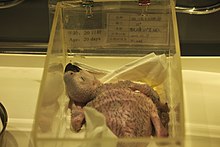
The blue-and-yellow macaw generally mates for life. They nest almost exclusively in dead palms and most nests are in Mauritia flexuosa palms. The female typically lays two or three eggs. The female incubates the eggs for about 28 days. One chick is dominant and gets most of the food; the others perish in the nest. Chicks fledge from the nest about 97 days after hatching. The male bird's color signals readiness for breeding. The brighter and bolder the colors, the better the chance of getting a mate.[7]
Conservation and threats[]
The blue-and-yellow macaw is on the verge of being extirpated in Paraguay, but it still remains widespread and fairly common in a large part of mainland South America. The species is therefore listed as Least Concern by BirdLife International. It is listed on CITES Appendix II, trade restricted.[1] Its population is estimated to be 1 million in the wild currently, which is just 50% of its population in 1980 (it had a wild population of 2 million in 1980).[citation needed]
Aviculture[]
Even well-tended blue-and-yellow macaws are known to "scream" for attention, and make other loud noises. Loud vocalizations, especially "flock calls", and destructive chewing are natural parts of their behavior and should be expected in captivity. Due to their large size, they also require plentiful space in which to fly around. According to World Parrot Trust, an enclosure for a blue-and-yellow macaw should, if possible, be at least 15 m (50 ft) in length.[8] Captive macaws, kept with good diet, exercise, and veterinary care are known to have lived 60 or more years.[9] People considering a macaw as a companion parrot must be aware of this and consider that the bird may outlive the owner.
The blue-and-yellow macaw has been noted to blush its bare facial skin and fluff the feathers of its cheeks, head and nape when interacting with humans. This may be an expression of the parrot's emotional state.[10]
Gallery[]
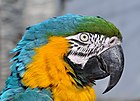
Head in high detail, Vogelburg (bird park), Weilrod, Germany
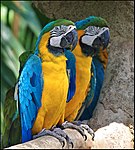
Two macaws, showing their colorful feathers
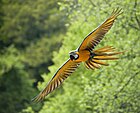
Flying at Zoo de Pont-Scorff, Morbihan, France
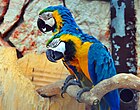
Sleepy couple at Weltvogelpark Walsrode (Walsrode Bird Park, Germany)

Blue and yellow macaw skeleton (Museum of Osteology)

At Walsrode Bird Park, Germany

Alligator Farm in Florida, US
Video clip
See also[]
References[]
- ^ a b c BirdLife International (2018). "Ara ararauna". IUCN Red List of Threatened Species. 2018: e.T22685539A131917270. doi:10.2305/IUCN.UK.2018-2.RLTS.T22685539A131917270.en. Retrieved 12 November 2021.
- ^ "Blue and Gold Macaws". The Spruce. Patricia Sund. Retrieved 19 October 2017.
- ^ "World Birds Taxonomic List". Zoonomen. Retrieved 31 October 2017.
- ^ a b ffrench, Richard; O'Neill, John Patton; Eckelberry, Don R. (1991). A guide to the birds of Trinidad and Tobago (2nd ed.). Ithaca, N.Y.: Comstock Publishing. ISBN 978-0-8014-9792-6.
- ^ Plair, B.L., Lal, M., Ramadhar, A., and Ramsubage, S. 2013. Status of Blue-and-yellow Macaws Ara ararauna Reintroduced to the Nariva Swamp, Trinidad and Tobago. Living World, Journal of The Trinidad and Tobago Field Naturalists' Club, 2013, 19-28.
- ^ Krishnan, Karunya. "Macaws on campus 'awesome' but noisy." The Miami Hurricane. 2009.
- ^ Alderton, David (2003). The Ultimate Encyclopedia of Caged and Aviary Birds. London, England: Hermes House. p. 235. ISBN 978-1-84309-164-6.
- ^ "Blue-and-yellow Macaw (Ara ararauna): Care". World Parrot Trust. Retrieved 26 September 2020.
- ^ "Blue & Gold Macaws aka Blue & Yellow Macaws". Beautyofbirds.com. Retrieved 24 April 2018.
- ^ Grrlscientist. "Macaws Communicate Their Emotions By Blushing And Fluffing Facial Feathers". Forbes. Retrieved 13 October 2021.
Further reading[]
- Doane, Bonnie Munro & Qualkinbush, Thomas (1994): My parrot, my friend : an owner's guide to parrot behavior. Howell Book House, New York. ISBN 0-87605-970-1
- Hilty, Steven L. (2003): Birds of Venezuela. Christopher Helm, London. ISBN 0-7136-6418-5
- Forshaw, J.M. Parrots of the World. New Jersey. T.F.H. Publications Inc. 1978. ISBN 0-87666-959-3
External links[]
| Wikimedia Commons has media related to Ara ararauna. |
 Data related to Ara ararauna at Wikispecies
Data related to Ara ararauna at Wikispecies- World Parrot Trust Parrot Encyclopedia – Species Profile
- Blue-and-yellow macaw videos, photos & sounds on the Internet Bird Collection.
- IUCN Red List least concern species
- Ara (genus)
- Macaws
- Birds of Colombia
- Birds of Venezuela
- Birds of Brazil
- Birds of the Guianas
- Birds of the Amazon Basin
- Birds of the Cerrado
- Birds of Trinidad and Tobago
- Birds of the Caribbean
- Birds of Panama
- Talking birds
- Feral parrots
- Species endangered by the pet trade
- Birds described in 1758
- Taxa named by Carl Linnaeus








